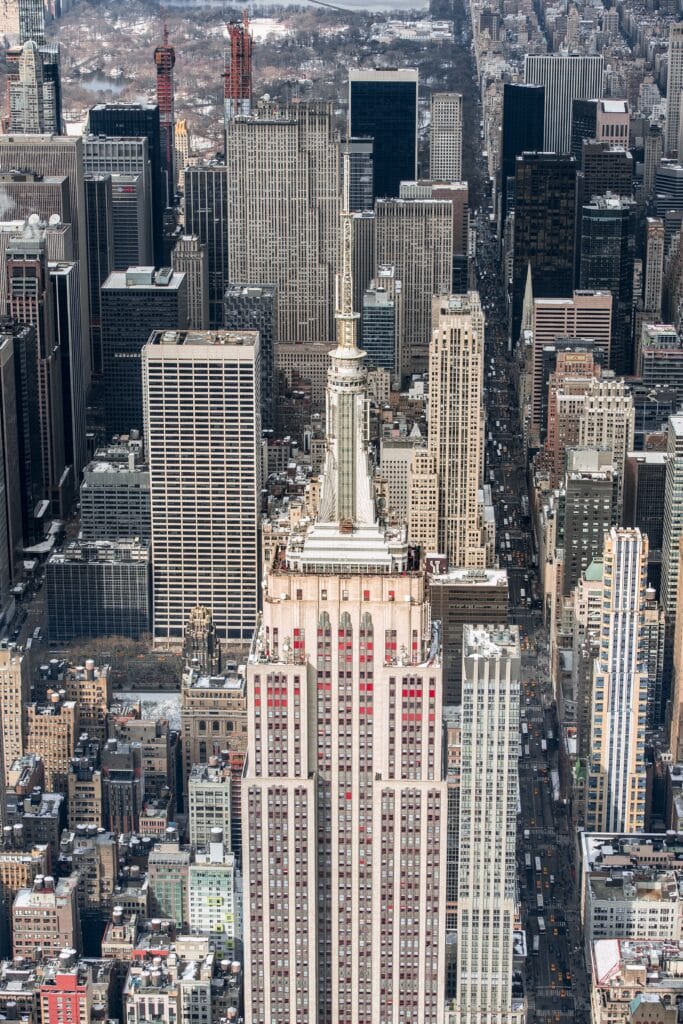
Get Local (97)
Understanding one of the most ambitious climate legislations
Written by Nicholas Strachovsky, ARMA Development Consultants | Case study provided by Reliable Power Alternatives Corporation
Why has this climate legislation passed?
Each time you turn on the news or check your phone, it feels like it is a pivotal time in history. We can see evolution all around us. It is certainly in technology with self-driving cars and drone delivery. It can be seen in continuous political controversy around the world and push for change. Global warming and climate change are now a constant discussion as well as the potential effects it may have. While there are still many that argue against climate change, you cannot argue that there seems to be an increase in extreme weather events. According to NOAA (National Oceanic and Atmospheric Administration) between 1980 and today there has been $1.754 trillion spent on extreme weather damage. Of that figure, $802 billion was spent from 2010-2019. There has been a steady increase each decade and it does not seem to be slowing.
It is widely believed that carbon emissions are the largest contributing factor to Climate Change. According to the EPA.gov pie chart, carbon emissions are greatest from the transportation industry.While that may be true, 12% is from building emissions. Of that 12%,the majority is produced by urban areas.The 100 highest-emitting urban areas account for roughly 18% of the global carbon footprint.In recent years, transportation and industry have been working to reduce their carbon impact. Although there are some good faith efforts from companies and individuals, much of the change is driven by the promise of new industry and revenue (electric vehicles), or stricter government requirements. The building industry has seen some of this push toward energy efficiency with the development of the Green Building Council, LEED, WELL Buildings, etc.… Many of the programs have had an impact but are also largely optional. None has had the impact needed to reduce the industries’carbon emissions on the same scale as is being done in other industries.
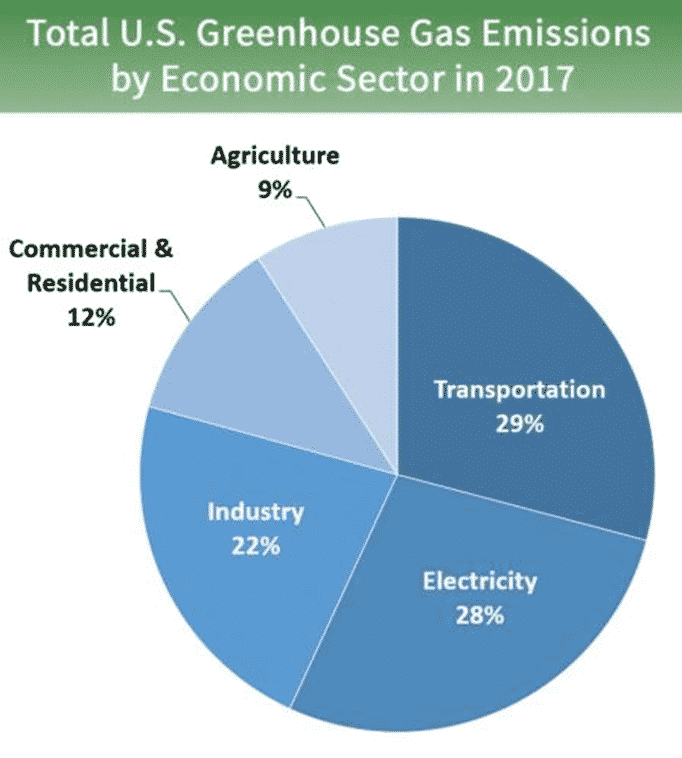
It is no secret that cities around the world compete to attract residents and businesses.All want to be an icon on the world stage. New York City is certainly one of the mainstays on the top cities of the world list. To be a leader, cities must lead by example. This is likely one of the reasons NYC is looking to implement one of the most ambitious climate legislations in the world. NYC has always worked to be a progressive city.With continual infrastructure upgrades, an elaborate transportation system, aggressive housing policies, and many other initiatives, New York continues to prove it is a leader among cities.With cities around the world working toward cleaner energy, so must the major cities in the USA. Carbon emissions and energy efficiency is the natural next phase of evolution and NYC’s aggressive climate policy is the latest step in its example of leadership.
What is this law?
On May 18, 2019 NYC passed Local Law 97. The goal is to reduce the city’s carbon emissions by 80% by the year 2050. Buildings represent nearly 70% of the cause of those emissions in NYC. It impacts over 57,000 buildings across the boroughs. This new law is not set to be implemented all at once, but rather rolled out over several years. Carbon reduction requirements will start to take effect in 2024. In the years 2024-2029, the law appears to target the 20% most carbon-intensive buildings. Years 2030 and on,will further restrict emissions and affect a larger portion of buildings. Currently, the law will only apply to buildings over 25,000sf. Of those affected buildings, exclusions are included, such as NYC owned properties and certain types of subsidized housing. There is also discussion of a carbon market where renewable energy credits can help buildings meet compliance as well as trading excess carbon efficiency to buildings that struggle to meet the requirements. All of this is outlined in the new law, but much of it is still being negotiated and finalized.
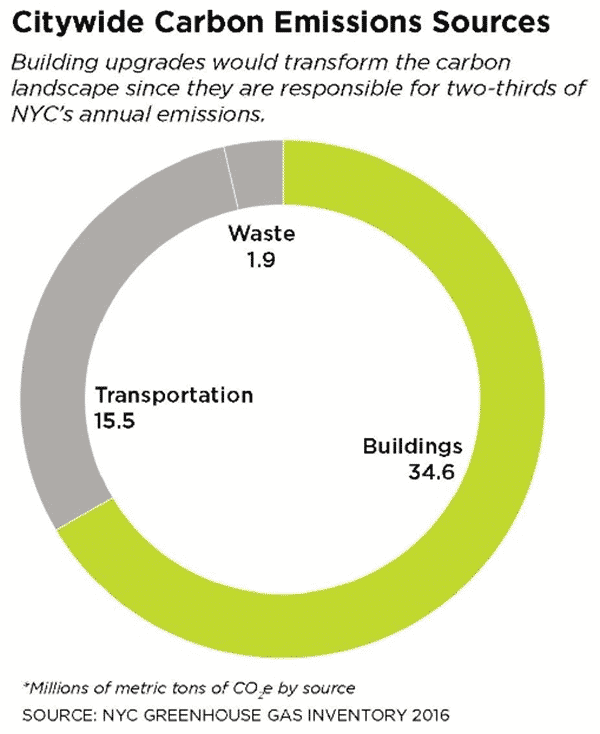
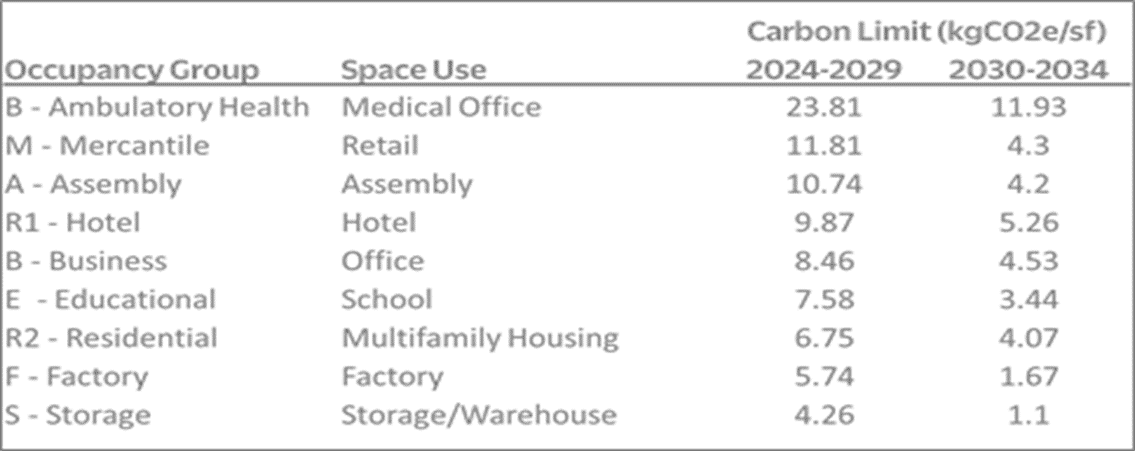
As building types and uses vary, so do the emission regulations faced by them. The building requirements vary by usage, see chart. To regulate compliance, all qualifying buildings are required to submit an annual report starting in 2025, outlining the building’s carbon emissions. There will be fines for any missing reports or non-compliance with stated limits. Now in industry regulations,there were circumstances where it was cheaper to pay fines rather than bear the expense to comply. This law is addressing that by implementing fines that would be comparable to the costs involved in bringing the building into compliance. Currently the fines are as follows:
- Failure to submit a report will result in a penalty of $.50 per square foot, for each month that the violation is not corrected within the 12 months following the reporting deadline.
- If your building emissions are higher than the allowable limit, you will be liable for a civil penalty: $268 for each metric ton over the building’s limit.
- False statement in the report (misdemeanor) is subject to a fine of not more than $500,000 or imprisonment of not more than 30 days or both such fine and imprisonment
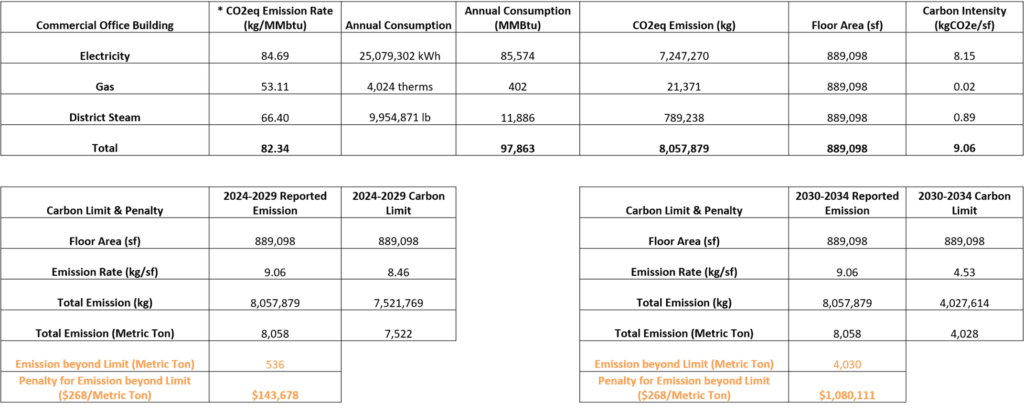
We have included a case study below demonstrating the impact on a typical commercial building.
As demonstrated above, the fines in years 2024-2029,increase exponentially as stricter requirements are implemented in 2030 and beyond. Fines in all years are impactful. While the cost to implement the efficiencies needed to comply may be high, there is a bright side.These upgrades will save energy and make the buildings more efficient to operate, saving money in the long run. It is the difficulty of coming up with short-term capital to complete this work that will likely be the biggest issue. Payback times may potentially be quite long in some instances.
What was there action to this new regulation?
It is obvious there has been extensive thought and consideration given to the details of this initiative,but still,Local Law 97 is raising many concerns throughout the real estate industry. While a major change to any industry regulations can induce fear and skepticism, few industries are more vulnerable than real estate.In real estate, impacts are extremely capital heavy, and one misstep can mean bankruptcy.To address these concerns, as well as provide further clarification and help implementation, the city has created a new agency; the Office of Building Energy and Emissions Performance.Based on mounting opposition to the law there should be plenty of work for the new office to review and address leading up to its implementation.
As soon as the law was announced, the critics started to mount.A prominent argument is that each sector of real estate has nuances that must be considered and currently are not.If this new law does not allow for flexibility to address these nuances, implementation can disproportionately affect sectors of the industry, some potentially detrimentally. A few examples of these nuances are commercial buildings and multi-family housing. In commercial buildings, the owner/landlord is in control of the energy efficiency and carbon emissions for the common areas and all mechanical systems that support those spaces. Tenants are often responsible for their own spaces and the equipment needed to support their space. Large tenants can take sizeable portions of these buildings, greatly contributing to the carbon footprint. Currently there is concern over the lack of accountability for tenants. If the law is focused on the owner, how will enforcement work if they have no recourse to control tenant systems? In multi-family development, budgets are often incredibly tight to make the deals work. This can be seen currently in the turmoil introduced to the sector by the new rent regulations.If not implemented with careful consideration, overly aggressive requirements may become cost-prohibitive, potentially hurting development and growth in a city with a large shortage of affordable housing. Some say the laws may even have the opposite effect on carbon emissions, by inhibiting and discouraging density which may go against the efficiencies found in urban development.
What can and should be done?
My firm, ARMA Development Consultants, is working on finding solutions and efficiencies to help.We have partnered up with Reliable Power Alternatives Corp to help building owners throughout this process.The fear we face, is the misperception of time and misunderstanding of impact.While the majority of buildings are not greatly affected until 2030, there will be impact felt by 2024, and in the life of construction, 10 years is not long, and 4 years is a flash. There is some speculation the law may be modified, and the impact lessened before full implementation. This is a possibility, but the financial risk is great if that does not happen. If you consider an average major renovation project takes 1-3 years or longer from design to completion, the clock is already ticking. Furthermore, the sheer volume of roughly 57,000 buildings being affected, will also tax the already busy professional construction trades throughout the city. If the law is implemented and a plan is not in place, buildings may face heavy fines before they are able to meet requirements. We have developed a team to help assess the needs of buildings effected by the law. We are modeling the emissions, not only in current buildings but that of new planned buildings, based on the intended systems as well. We are carefully assembling proper teams for each sector of real estate to ease the process and efficiently help buildings into compliance. We are working with lenders as well to identify organizations with better terms or other incentives for energy efficient buildings.Our team can manage this entire process from initial assessment and identifying funding through design and full implementation.
Should all qualifying buildings act now?
It really depends on the circumstances, we feel that all owners need to be aware and have their buildings modeled as soon as possible. If you are planning on building new, or performing any upgrades, it is paramount to make sure all planned work will push your building toward compliance beyond 2030.Incorporating deep retrofits into capital planning now can help balance operations budgets going toward law deadlines. While in a field like technology, equipment is obsolete in a few years, many current building systems will not be scheduled for upgrade again for 15-20 years or longer. There will likely be some adjustment to the law as implementation moves ahead and political environments change.Even with adjustments, based on other city and industry advancements toward cleaner energy and renewable energy sources becoming more mainstream, it is unlikely this type of regulation will go away. In fact, there are similar regulations being explored in other cities throughout the country. While expensive and painful,more efficient buildings lead to less spent operating buildings and steps toward a cleaner environment for future generations.Ambitious legislations such as this are the driving force needed to enact change. Many details remain to be finalized. Hopes of retraction are not the answer. Involvement in the process to help understand the industry and development of smart methods for efficiency, are what is needed. Ambitious laws we develop today lead to better standards of building tomorrow; it is evolution.
K.O.W. ARMA Development Consultants specializes in Owner Representation and Program Management. We take a customized multi-faceted approach to each project. While the hired professionals are focusing on details of the build, our focus is on ensuring all parties are following their defined roles and communicating. Unfortunately, most of the design and construction industry is reactive. This stems from the intricacy needed to construct and renovate these buildings and the attention to detail needed to do it well. With that type of hyper-focus needed we are there to work with the team to keep focus ahead and push for a proactive approach during all phases of the project.
Related Articles

Designing Green
Paul de Ruiter designs the energy efficient homes we need, one in the suburbs, the other in the country
Read More
Green Lodging Abroad
The future of hospitality, luxury merges seamlessly with sustainability at QO Hotel Amsterdam, a new design by Paul de Ruiter and Mulderblauw
Read More
ADVERTISE WITH EQ
ebunn@equicapmag.com
dhilpert@equicapmag.com
Popular Posts








